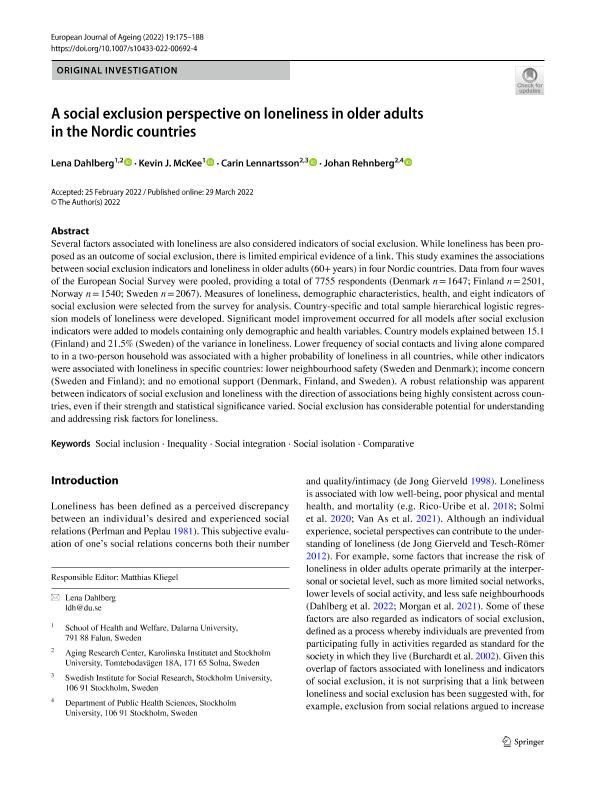| LDR | | | 00000cab a2200000 4500 |
| 001 | | | MAP20220017183 |
| 003 | | | MAP |
| 005 | | | 20220609154553.0 |
| 008 | | | 220609e20220606esp|||p |0|||b|spa d |
| 040 | | | $aMAP$bspa$dMAP |
| 084 | | | $a931.2 |
| 245 | 0 | 2 | $aA Social exclusion perspective on loneliness in older adults in the Nordic countries$cLena Dahlberg...[et.al.] |
| 520 | | | $aSeveral factors associated with loneliness are also considered indicators of social exclusion. While loneliness has been proposed as an outcome of social exclusion, there is limited empirical evidence of a link. This study examines the associations between social exclusion indicators and loneliness in older adults (60+ years) in four Nordic countries. Data from four waves of the European Social Survey were pooled, providing a total of 7755 respondents (Denmark n = 1647; Finland n = 2501, Norway n = 1540; Sweden n = 2067). Measures of loneliness, demographic characteristics, health, and eight indicators of social exclusion were selected from the survey for analysis. Country-specific and total sample hierarchical logistic regression models of loneliness were developed. Significant model improvement occurred for all models after social exclusion indicators were added to models containing only demographic and health variables. Country models explained between 15.1 (Finland) and 21.5% (Sweden) of the variance in loneliness. Lower frequency of social contacts and living alone compared to in a two-person household was associated with a higher probability of loneliness in all countries, while other indicators were associated with loneliness in specific countries: lower neighbourhood safety (Sweden and Denmark); income concern (Sweden and Finland); and no emotional support (Denmark, Finland, and Sweden). A robust relationship was apparent between indicators of social exclusion and loneliness with the direction of associations being highly consistent across countries, even if their strength and statistical significance varied. Social exclusion has considerable potential for understanding and addressing risk factors for loneliness.
|
| 540 | | | $aLa copia digital se distribuye bajo licencia "Attribution 4.0 International (CC BY 4.0)"$f$uhttps://creativecommons.org/licenses/by/4.0$943 |
| 650 | | 4 | $0MAPA20100044407$aPersonas mayores |
| 650 | | 4 | $0MAPA20080571498$aCalidad de vida |
| 651 | | 1 | $0MAPA20090028753$aPaíses Escandinavos |
| 700 | 1 | | $0MAPA20220005913$aDahlberg, Lena |
| 773 | 0 | | $wMAP20210024146$g06/06/2022 Volumen 19 Número 2 - 2022 , p. 175-188$tEuropean Journal of Ageing : social, behavioural and health perspectives$dCham, Switzerland [etc.] : Springer International Publishing AG, 2021- |
| 856 | | | $qapplication/pdf$w1115692$yRecurso electrónico / Electronic resource |


